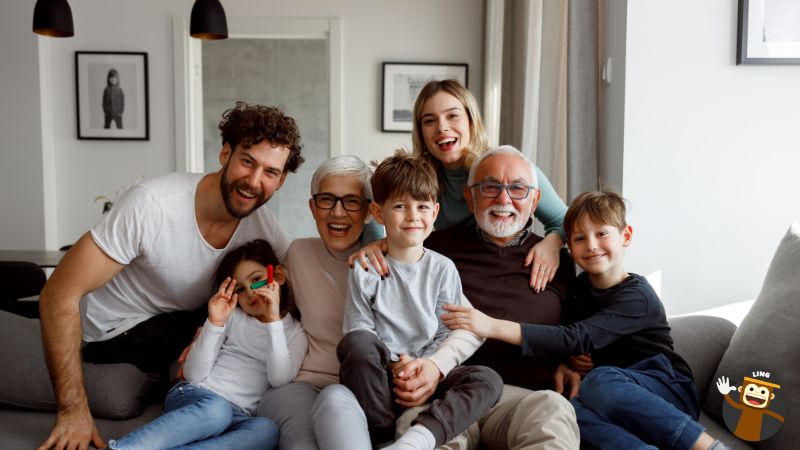Are you curious to know how to say the most common Danish vocabulary for family? If Danish friends invite you over, or if you visit Denmark, it is very useful to know the words for family members and relatives.
It is common to end up speaking about family, and you do not want to be taken off guard when that happens. So, for example, when you meet new people, they can tell you they have a brother or a sister, a cousin or other relatives.
Most Common Danish Vocabulary For Immediate Family
Family words are easy to learn and common to hear during a conversation. A traditional Danish family includes at least a wife and husband and one or two kids. But, they can have many relatives and family members, and it is always better to know how to say those words.
Here are the most common Danish words related to immediate family members:
- Mor – Mother
- Far– Father
- Kone – Wife
- Ægtemand – Husband
- Forældre – Parents
- Datter – Daughter
- Søn – Son
- Søster – Sister
- Bror– Brother
- Lillesøster – Younger sister
- Børn – Children / kids
- Barn – Child
- Storebror – Older brother
- Bedstemor– Grandmother
- Partner – Partner
- Fætter – Cousin
- Mand og kone– Husband and wife
- Halvbror – Half-brother
There are more useful words and phrases you can learn that focus on the family.
Most Common Danish Vocabulary For The Rest Of The Family

Families can be big, and it is helpful to know the words related to step-family members and other relatives.
Here they are:
- Tante – Aunt
- Bedstefar – Grandfather
- Svigerfar– Father-in-law
- Svigermor – Mother-in-law
- Svigerinde – Sister-in-law
- Svigerdatter – Daughter-in-law
- Svigersøn – Son-in-law
- Svoger – Brother-in-law
- Stedfar – Stepfather
- Stedmor – Stepmother
- Udvidet familie – Extended family
- Niece – Niece
- Familie venner – Family friends
- Værge – Guardian
- Søskende – Sibling
- Stedbarn – Stepchild
- Plejeforældre – Foster parents
Other Words Related To Family
During a conversation, you might encounter other words related to family but do not necessarily represent a family member.
Here they are:
- Gæst – Guest
- Pårørende – Relatives
- Forfædre – Ancestors
- Forlovede – Engaged
- Elsker – Lover
- Ægtefælle – Spouse
- Familie – Family
- Familier – Families
- Familie medlemmer – Family members
Common Sentences Used By Family Members

Speaking Danish can be easier if you learn a few sentences to use in particular circumstances, such as with a Danish family or in a household with several members.
Here are some useful Danish words and phrases:
- Sluk for tv’et og gå i seng – Turn off the tv and go to sleep
- Aftensmaden er klar – Dinner is ready
- Vask dine tænder – Wash your teeth
- Luk lysene, før du forlader huset – Close the lights before leaving the house
- Ryd op på dit værelse – Clean your room
- Lav dine lektier – Do your homework
- Tag affaldet udenfor – Take the garbage outside
- Færdiggør din mad – Finish your food
- Sænk musikken – Lower the music
- Hjælp din søster – Help your sister
- Hjælp mig med madlavning – Help me with food preparation
- Tag hunden med ud at gå en tur – Bring the dog out for a walk
- Tal ikke med fremmede – Don’t talk to strangers
- Giv mad til hunden – Give food to the dog
- Spil kort med mig – Play cards with me
- Hjælp mig med at vaske op – Help me to wash the dishes
Danish Traditions That Are Family Focused
Throughout the year, there are many festivities and events. Danish families spend time together during those events, cooking, celebrating, and sometimes during outdoor activities.
Here are some of those traditions:
Eastern
Eastern is a big event for family members. They get together for an Eastern lunch, which usually lasts several hours. The purpose of the lunch is to spend time together. Families also paint hard-boiled eggs, go on egg hunting, and play different games with the children.
Midsummer
Danish and Swedish people celebrate Midsummer in June. It is called the festival of St. John the Baptist. It is a celebration of summer, celebrated around the summer solstice. It is one of the year’s most significant events and is celebrated with family and friends.
Dinner is served at home, while people usually go to a community bonfire in a park or beach.
Christmas
Danes spend Christmas day with family. The celebration starts with the big dinner on Christmas eve on December 24. During this time, the country is shut off, and few people are around.
Most of the Danes are at home with their families. As part of the festivity, homes and streets are decorated with colorful lights, which contribute to creating a friendly atmosphere. In general, during the following days, Danes visit relatives and friends.
Christmas and the Christmas holidays are meant to strengthen family and friends’ relationships.
New Year’s Eve
New year’s Eve celebration is another big occasion to spend with family, although many Danes opt to go out and celebrate with friends or to a party. But, it is common for Danish people to hold big dinners and parties in their houses, inviting the rest of their family and even friends.
But even if Danes might go out to a restaurant to celebrate, it is very common to go there with family and friends.
Would you like to learn more about the Danish language?
Learn Danish With Ling App!

If you want to improve your knowledge of the Danish language and become fluent quickly, you can use the Ling App.
With this tool, you can take video lessons and learn grammar, pronunciation, verbs, and many more words. You can also learn many aspects of the Danish culture that can help you understand Danes and proper etiquette.
In addition, if you want to learn additional languages, you can choose between more than 60 options. Ling is an excellent application compatible with every mobile device and can help you learn on the go.
Besides, our blog is constantly updating to teach you different essential cultural and language-related topics. Read more articles such as Easy Names Of Top Vegetables In Danish and apologies in Danish.
Start this fun and efficient experience today. Download from App Store and Play Store for free.












